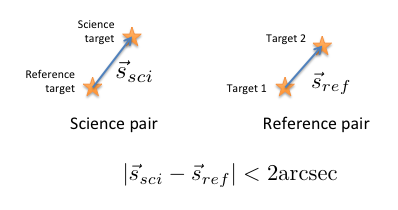The configuration for astrometry is completely identical to ASTRA-DFPR. The only difference is that instead of performing V2 sequences on the observed pair, the emphasis is on the measurement of the optical path difference between the two objects, to be turned into a measurement of the angular separation between the two objects projected on the interferometer baseline. This measurement is obtained through the combination of fringe tracker and internal metrology data for the optical path difference, and baseline motion data for the baseline itself.
To help meet the baseline stability requirement, the ASTRA team has designed a differential narrow angle astrometry observation scheme, which requires that the proposer find a reference pair close to the science pair of interest. This reference pair should have a similar separation distance and angle than the science pair. The geometry of the configuration is illustrated in the figure below.

To maximize the science, performance characterization and engineering benefits of TAC-allocated science during the shared-risk availability, science teams are strongly encouraged to collaborate with the NSF-funded ASTRA development team throughout the science process from planning to publication (contact Julien Woillez for more information about ASTRA). To recognize their contribution, publications based on DFPR data are strongly encouraged to include ASTRA team co-authors.
As of today, Astrometry has not been demonstrated on-sky. All the
required components for an astrometric measurement are in place and
characterization of the astrometric performance is under way. Achieved
performance will be confirmed in time for 2012A.
Proposals for Astrometry mode
MUST
include the
following items (note that the PI is responsible for identifying
appropriate science and reference pairs as part of the proposal
phase):
Return to KI Sensitivities
page
Return to the KI Support page